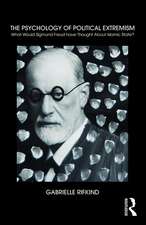Intersubjective Self Psychology: A Primer
Editat de George Hagman, Harry Paul, Peter B. Zimmermannen Limba Engleză Hardback – 8 mai 2019
Retaining Kohut’s emphasis on the self and selfobject experience, the book conceptualizes the therapeutic situation as a bi-directional field of needed and dreaded selfobject experiences of both patient and analyst. Through a rigorous application of the ISP model, each chapter sheds light on the complex dynamic field within which self-experience and selfobject experience of patient and analyst/therapist unfold and are sustained. The ISP perspective allows the therapist to focus on the patient’s strengths, referred to as the Leading Edge, without neglecting work with the repetitive transferences, or Trailing Edge. This dual focus makes ISP a powerful agent for transformation and growth.
Intersubjective Self Psychology provides a unified and comprehensive model of psychological life with specific, practical applications that are clinically informative and therapeutically powerful. The book represents a highly useful resource for psychoanalysts and psychoanalytic psychotherapists around the world.
| Toate formatele și edițiile | Preț | Express |
|---|---|---|
| Paperback (1) | 277.19 lei 3-5 săpt. | +35.22 lei 10-14 zile |
| Taylor & Francis – 7 mai 2019 | 277.19 lei 3-5 săpt. | +35.22 lei 10-14 zile |
| Hardback (1) | 945.80 lei 6-8 săpt. | |
| Taylor & Francis – 8 mai 2019 | 945.80 lei 6-8 săpt. |
Preț: 945.80 lei
Preț vechi: 1153.41 lei
-18% Nou
Puncte Express: 1419
Preț estimativ în valută:
180.97€ • 189.46$ • 149.75£
180.97€ • 189.46$ • 149.75£
Carte tipărită la comandă
Livrare economică 05-19 aprilie
Preluare comenzi: 021 569.72.76
Specificații
ISBN-13: 9781138354531
ISBN-10: 1138354538
Pagini: 220
Dimensiuni: 156 x 234 x 14 mm
Greutate: 0.45 kg
Ediția:1
Editura: Taylor & Francis
Colecția Routledge
Locul publicării:Oxford, United Kingdom
ISBN-10: 1138354538
Pagini: 220
Dimensiuni: 156 x 234 x 14 mm
Greutate: 0.45 kg
Ediția:1
Editura: Taylor & Francis
Colecția Routledge
Locul publicării:Oxford, United Kingdom
Public țintă
Postgraduate and ProfessionalCuprins
Author Biographies
Preface
Acknowledgements
George Hagman, Peter B. Zimmermann, and Harry Paul.
Section One: The Theory and Practice of Intersubjective Self Psychology
Chapter 1: An Introduction to Intersubjective Self Psychology
Peter B. Zimmermann, Harry Paul, Aviva Rohde, Karen Roser, Gordon Powell, Louisa Livingston, and George Hagman
Chapter 2: Empathy in Intersubjective Self Psychology
Karen Roser and Aviva Rohde
Chapter 3: Transference in the Intersubjective Self Psychology.
Aviva Rohde and Karen Roser
Chapter 4: The Therapeutic Action of Intersubjective Self Psychology, Part 1
Peter B. Zimmermann
Chapter 5: The Therapeutic Action of Intersubjective Self Psychology, Part 2: The Case of Ricky
Aviva Rohde
Chapter 6: Working with the Trailing Edge: Resolving the Fear of Repetition
George Hagman and Susanne Weil
Chapter 7: Working with the Leading Edge: When the Selfobject Tie is Intact.
Harry Paul and George Hagman, and Peter B. Zimmermann
Section Two: Clinical Applications
Chapter 8: Melancholia Revisited: Depression and its Treatment from the Perspective of Intersubjective Self Psychology
Peter B. Zimmermann
Chapter 9: Addiction: An Intersubjective Self Psychological Perspective
Harry Paul
Chapter 10: Child Treatment: Working with the Leading and Trailing Edge
Karen Roser
Chapter 11: Working with Couples in Intersubjective Self Psychology
Nancy Hicks and Louisa Livingston
Chapter 12: Sexuality in Intersubjective Self Psychology: What Matters
Gordon Powell
Chapter 13: A Suicidal Patient: Gasping for Air:
Laura D’Angelo
References
Preface
Acknowledgements
George Hagman, Peter B. Zimmermann, and Harry Paul.
Section One: The Theory and Practice of Intersubjective Self Psychology
Chapter 1: An Introduction to Intersubjective Self Psychology
Peter B. Zimmermann, Harry Paul, Aviva Rohde, Karen Roser, Gordon Powell, Louisa Livingston, and George Hagman
Chapter 2: Empathy in Intersubjective Self Psychology
Karen Roser and Aviva Rohde
Chapter 3: Transference in the Intersubjective Self Psychology.
Aviva Rohde and Karen Roser
Chapter 4: The Therapeutic Action of Intersubjective Self Psychology, Part 1
Peter B. Zimmermann
Chapter 5: The Therapeutic Action of Intersubjective Self Psychology, Part 2: The Case of Ricky
Aviva Rohde
Chapter 6: Working with the Trailing Edge: Resolving the Fear of Repetition
George Hagman and Susanne Weil
Chapter 7: Working with the Leading Edge: When the Selfobject Tie is Intact.
Harry Paul and George Hagman, and Peter B. Zimmermann
Section Two: Clinical Applications
Chapter 8: Melancholia Revisited: Depression and its Treatment from the Perspective of Intersubjective Self Psychology
Peter B. Zimmermann
Chapter 9: Addiction: An Intersubjective Self Psychological Perspective
Harry Paul
Chapter 10: Child Treatment: Working with the Leading and Trailing Edge
Karen Roser
Chapter 11: Working with Couples in Intersubjective Self Psychology
Nancy Hicks and Louisa Livingston
Chapter 12: Sexuality in Intersubjective Self Psychology: What Matters
Gordon Powell
Chapter 13: A Suicidal Patient: Gasping for Air:
Laura D’Angelo
References
Notă biografică
George Hagman, LCSW is a clinical social worker and psychoanalyst in private practice in New York City and Stamford, Connecticut. He is a member and faculty member of the Training and Research Institute in Intersubjective Self Psychology, and the Westchester Center for the Study of Psychoanalysis and Psychotherapy. He is the author of books on the Psychoanalysis, Self Psychology, art, and bereavement.
Harry Paul, PhD, is a clinical psychologist in private practice in New York City and Chappaqua, New York. He is a founding member, past president, faculty, supervisor and training analyst at the Training and Research Institute in Intersubjective Self Psychology. He is the co-author of The Self Psychology of Addiction and Its Treatment: Narcissus in Wonderland, and he has co-authored papers on addiction and self psychology. He currently sits on the international Council of IAPSP.
Peter B. Zimmermann, PhD, is a licensed psychoanalyst in private practice in New York City. He is a founding member, and member board of trustees, faculty, supervisor and training analyst at the Training and Research Institute in Intersubjective Self Psychology in New York. He is the current president, senior faculty member, supervisor and training analyst at the Training Institute of The National Psychological Association for Psychoanalysis in New York.
Harry Paul, PhD, is a clinical psychologist in private practice in New York City and Chappaqua, New York. He is a founding member, past president, faculty, supervisor and training analyst at the Training and Research Institute in Intersubjective Self Psychology. He is the co-author of The Self Psychology of Addiction and Its Treatment: Narcissus in Wonderland, and he has co-authored papers on addiction and self psychology. He currently sits on the international Council of IAPSP.
Peter B. Zimmermann, PhD, is a licensed psychoanalyst in private practice in New York City. He is a founding member, and member board of trustees, faculty, supervisor and training analyst at the Training and Research Institute in Intersubjective Self Psychology in New York. He is the current president, senior faculty member, supervisor and training analyst at the Training Institute of The National Psychological Association for Psychoanalysis in New York.
Recenzii
"This book has many voices but one goal: to describe a new model for contemporary psychoanalysis. The authors develop its meaning from many rich and diverse perspectives. Sensitive cases illustrate the theory and make it more accessible for clinicians. This is a path-breaking and essential volume for anyone searching for coherence in the maze of contending approaches to psychotherapy that dominate the landscape." --Charles B. Strozier, PhD., Author, Heinz Kohut: The Making of a Psychoanalyst"In this lucid and well-articulated volume, we are introduced to the intersection of Kohutian Self Psychology and Intersubjectivity Theory. Readers will find in this book accessible theoretical explanations, which are illustrated by excellent clinical examples. This is a must read for clinicians interested in this innovative approach to clinical work." --Joyce Slochower, Ph.D., ABPP, Professor Emerita, Hunter College & CUNY; Faculty NYU Steven Mitchell Center; Author, Holding and Psychoanalysis: A Relational Perspective & Psychoanalytic Collisions
"This book offers students, as well as experienced clinicians, a clear and skillfully illustrated guidebook that combines the most transformative aspects of Heinz Kohut’s and Robert Stolorow’s contributions. The chapters in the book abound with clinical examples for using this approach to treat individuals, children, and couples and in working with depression, addiction, suicidality, and sexuality." --Doris Brothers, Ph.D. Private practice, New York City, Author, Falling Backwards: An Exploration of Trust and Self Experience and Towards a Psychology of Uncertainty
"This book offers students, as well as experienced clinicians, a clear and skillfully illustrated guidebook that combines the most transformative aspects of Heinz Kohut’s and Robert Stolorow’s contributions. The chapters in the book abound with clinical examples for using this approach to treat individuals, children, and couples and in working with depression, addiction, suicidality, and sexuality." --Doris Brothers, Ph.D. Private practice, New York City, Author, Falling Backwards: An Exploration of Trust and Self Experience and Towards a Psychology of Uncertainty
Descriere
Intersubjective Self Psychology: A Primer offers a comprehensive overview of the theory of Intersubjective Self Psychology and its clinical applications.

























